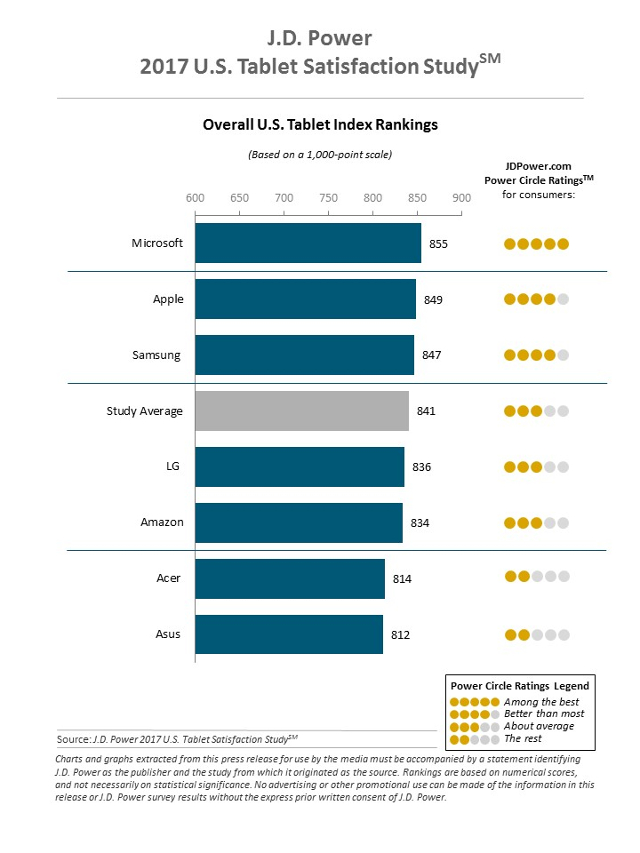Microsoft Surface beats Apple iPad in overall customer satisfaction according to J.D. Power

According to a recent J.D. Power study (2017 U.S. Tablet Satisfaction), Microsoft's Surface tablets have beaten Apple's iPad in overall customer satisfaction. This is significant, as it is the first time it has ever happened. The Windows-maker had not been able to topple Apple in this regard, so surely there is some champagne-popping going on at Microsoft headquarters.
While high satisfaction is definitely something to be proud of, the study is arguably flawed. Why do I say this? The Surface tablets are an entirely different product class than the iPad. True, they are both "tablets" as they are rectangular and feature touch screens, but Microsoft's offerings are desktop and laptop replacements -- Apple's tablet products are primarily secondary devices. It simply doesn't make sense to compare them.
In other words, a Surface Pro without a keyboard, used only as a tablet for consumption and gaming is inferior compared to iPad. On the flip side, the Surface with keyboard and mouse is superior to iPad for productivity as a desktop/laptop replacement. Like I said, comparing them is foolish, as they are entirely different.
Even the iPad Pro devices run a mobile operating system -- not a desktop class OS like Windows 10. In fact, the study highlights that consumers highly valued the keyboard and mouse compatibility of Surface. Think about that for a moment -- one of the respondents' favorite aspects of the Surface tablet is when they aren't using it as a tablet! iOS does not even offer mouse support.
"In features, Microsoft is the highest performer in three areas: variety of pre-loaded applications; internet connectivity; and availability of manufacturer-supported accessories. Microsoft Surface users have the highest incidences of accessory use, which underscores the device’s versatility. These accessories include a stylus (48 percent vs. 27 percent industry average); physical keyboard (51 percent vs. 14 percent); and mouse (27 percent vs. 6 percent), all of which have higher satisfaction. Microsoft also achieves the highest ratings in these features attributes: variety of input/output connectivity and amount of internal storage available," says J.D. Power.

The company further says, "Microsoft also has a higher proportion of younger customers than their competitors. Microsoft customers are notably more likely to consider productivity features as important. For example, when customers are asked the importance of their tablet to perform certain jobs well, Microsoft owners have the highest incidence of saying 'very important' for jobs related to productivity. These include browsing the internet (90 percent vs. 75 percent industry average); emailing (76 percent vs. 61 percent); word processing (63 percent vs. 30 percent); and mobile payments/banking (53 percent vs. 40 percent)."
J.D. Power shares the following significant findings from the study.
- Satisfaction is rising: Overall customer satisfaction with tablet devices is 841, an increase of 21 index points from the 2016 U.S. Tablet Satisfaction Study—Volume 2, released six months ago.
- Driving the selection process: Lower price and past experience are the most commonly cited reasons for tablet selection among customers (22 percent each). Reputation is next at 19 percent.
- Size matters: The average screen diagonal among Microsoft customers is highest, at 11.8 inches. Satisfaction is 869 among customers whose screen diagonal is 10 inches or more vs. 850 among those whose screen diagonal is 8-10 inches and 824 among those whose screen diagonal is less than 8 inches.
- Data plans increase satisfaction: Nearly one-third (32 percent) of customers have a data plan with their tablet. Overall satisfaction among customers with a data plan is 863 vs. 834 among those without such a plan.
Ultimately, while the study is valid if you consider all tablets to be the same, that simply isn't the case in real life. With that said, I do not want to take anything away from Microsoft's win here. Look, the Surface tablets are absolutely brilliant -- a college student looking for a computer would be wise to choose Surface. For someone looking to relax on a couch and consume content, or play a game, however, the iPad would be much more satisfying.
Both are great, but it is apples and oranges.
Photo credit: Luis Molinero / Shutterstock
